Renault /Dacia Sandero vehicles are equipped with rack and pinion steering
Mostly cars are equipped with power steering.
The steering gear consists of two steering rods connected by ball joints to the levers of the steering knuckles of the front suspension.
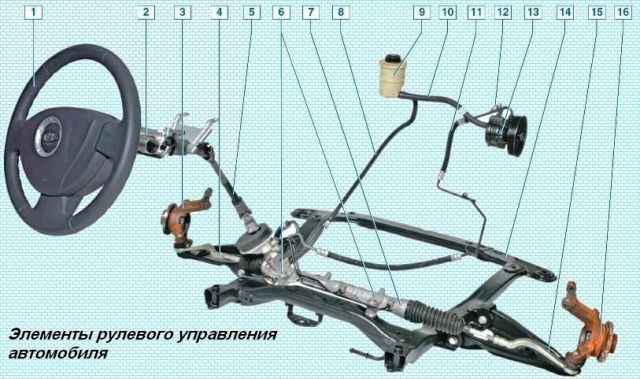
1 - steering wheel; 2 - steering column; 3 - left knuckle assembly with hub; 4 - left tie rod end; 5 - intermediate shaft; 6 - bolts for fastening the crankcase of the steering mechanism to the subframe; 7 - steering gear housing; 8 - drain line of the hydraulic booster; 9 - hydraulic booster reservoir; 10 - hydraulic booster filling line; 11 - pressure line of the hydraulic booster; 12 - hydraulic booster fluid pressure sensor; 13 - hydraulic booster pump; 14 - subframe; 15 - right tie rod end; 16 - right steering knuckle assembly with hub
The steering mechanism is mounted on the front suspension subframe and secured to it with two bolts.
In the crankcase of the steering mechanism, the rack is pressed against the gear shaft by a spring through the stop.
The side clearance between the gear and the rack is adjusted by rotating the adjusting plug, which compresses the spring.
Adjustment is carried out when assembling the steering mechanism at the factory.
The steering gear consists of two steering rods connected to the steering gear rack and steering knuckle levers.
Each rod is attached with its inner end to the steering rack through a non-separable ball joint - the threaded tip of the hinge is screwed into the hole in the rack.
In the middle part of the steering rod there is a hexagon turnkey “13”, and on the outer end there is a thread onto which the rod end is screwed.
The tie rod end has a non-separable ball joint that does not require replenishment of the lubricant supply, which is embedded inside it for the entire service life.
The right and left tie rods are the same, but the ends are different.
The connection of the steering rack and the tie rod ball joint is protected from dirt and moisture by a corrugated rubber boot.
The cover is fixed with a steel disposable clamp on the steering gear housing, and the cover is held on the steering rod by a spring clamp - while the narrow belt of the cover must coincide with the groove made on the steering rod.
The steering column shaft is attached to the steering gear shaft through an intermediate shaft with two cardan joints.
A steering wheel is mounted on the splines in the upper part of the steering column shaft.
The steering column is attached to the cross member bracket located under the instrument panel.
The power steering system includes: a steering gear, a pump, a radiator for cooling the working fluid, a reservoir for working fluid and connecting pipes of the lines.
The pump is driven by a belt from the accessory drive pulley.
Hydraulic fluid from the reservoir enters the pump, and from it it is supplied under high pressure to the distribution device located in the steering gear housing and mechanically connected to the steering column shaft.
A hydraulic cylinder piston is fixed on the gear rack of the steering gear.
When the steering wheel is turned, the switchgear connects one of the hydraulic cylinder chambers to the pump discharge line, and the other chamber to the drain.
At the same time, due to the pressure difference of the working fluid, the hydraulic cylinder piston moves the rack to the left or right and through the steering rods, and the fist levers turn the steered wheels of the car.
If the hydraulic booster fails, the ability to drive the car remains, but the force on the steering wheel increases.
Possible steering problems and solutions
- Cause of malfunction
Remedy
Increased steering wheel play and steering knock:
- Loosening the steering gear mounting bolts
Tighten the bolts
- Tie rod ball joint wear
Replace hinges
- Steering shaft universal joint wear
Replace steering shaft
Difficulty turning the steering wheel:
- Slippage of the power steering pump drive belt
Change the belt
- Damage to the pump drive belt
Change the belt
- Insufficient working fluid level
Restore the level to normal
- Air entering the hydraulic system
Remove air
- Twisted or damaged hoses
Remove kinks or replace hoses
- Insufficient pressure of the power steering pump
Replace pump
- Increased internal leakage in us ose
Replace pump
- Fluid leaks from the steering gear
Replace defective parts
Fuzzy return of the steering wheel to the middle position:
- Difficulty turning internal joints or tie rod ends
Replace tie rod ends
- Steering rack deformation
Replace steering gear
- Gear bearing damage
Replace steering gear
- Twisted or damaged power steering hoses
Remove kinks or replace hoses
- Damage to the pressure control valve
Replace pressure control valve
- Damage to the pump rotor shaft bearing
Replace pump
Noise (knocking) in the steering:
- Loosening the steering gear mounting bolts
Tighten the bolts
- Loose steering rods or ball joints of the tie rod ends
Tighten the nuts
- Wear of ball joints
Replace worn parts
Increased noise level of the power steering pump:
- Insufficient working fluid level
Restore fluid level to normal
- Air entering the hydraulic system
Remove air
- Loosening the pump mounting bolts
Tighten the bolts
Steering test
When using the car, you should regularly check the condition of the steering
During inspection, special attention should be paid to the condition of protective covers and threaded connections.
Torn, cracked rubber boots must be replaced, otherwise water, dust and dirt that get into the nodes will quickly disable the nodes.
On vehicles with power steering, check the condition of pipelines and hoses.
Turning the steering wheel from lock to lock, you need to check by ear:
- - reliability of fastening of the steering mechanism and steering wheel;
- - lack of clearance in the tie rod bushings and ball joints of the tie rod ends;
- - reliability of tightening and locking of the steering rod joints and ball joint pin nuts;
- - lack of jamming and interference preventing the steering wheel from turning.
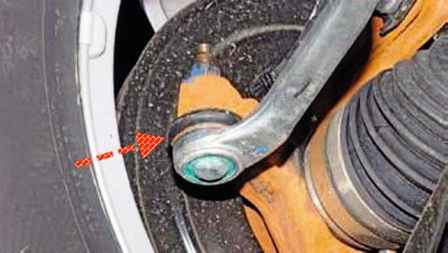
Checking the condition of the protective covers of the tie rod ends
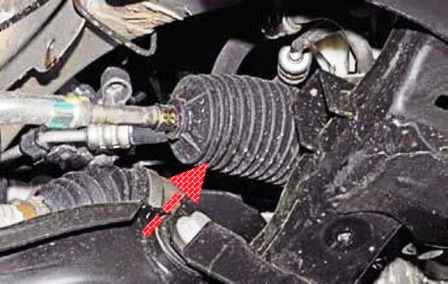
Replace torn, cracked covers
Turning the steering wheel sharply in both directions, we check (with the help of an assistant) visually and aurally the fastening of the steering mechanism

Movement on the fastening bolts (arrows in the figure) of the mechanism and knocks are not allowed.
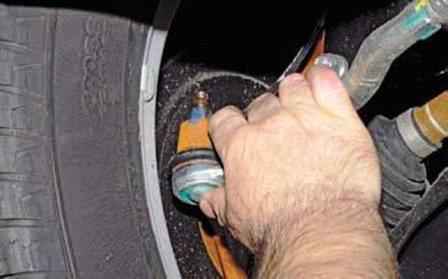
You also need to check for play in the ball joints of the tie rod ends.
Tips, hinges that have noticeable play need to be replaced
Checking the free play of the steering wheel
This will require: a ruler, chalk, or wire for marking
Installing the front wheels in a forward-facing position
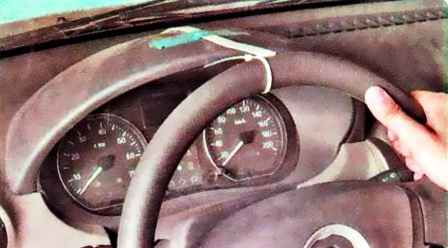
Set the ruler so that its end rests against the instrument panel, and the plane of the ruler touches the outer surface of the steering wheel rim.
Without changing the position of the ruler, turn the steering wheel to the right until the front wheels start to turn.
In this position, you need to put a mark on the steering wheel rim (or fix the wire or plastic clamp)
Without changing the position of the ruler, turn the steering wheel to the left until the front wheels start turning.
In this position, put a second mark on the steering wheel rim

We measure the distance between the marks along the rim. It should not exceed the calculated value.
If the rudder free play is greater, the cause must be found and corrected.
The play must not exceed 5°
For a steering wheel whose outer diameter is 360 mm, the play should not exceed 15-17 mm.




